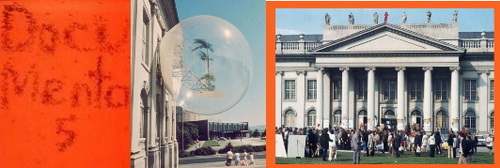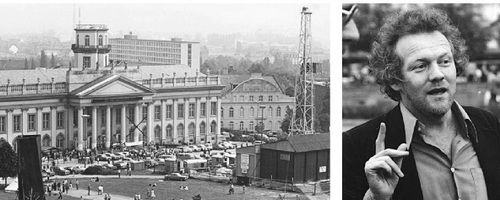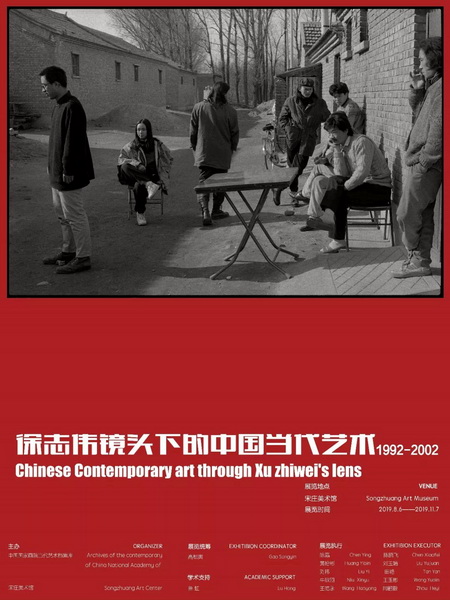Introducing the Documenta in Kassel
蔡青译文 Cai Qing translation
Documenta 5
30 June – 8 October 1972
Artistic Director: Harald Szeemann (Secretary-General)
Venues:Museum Fridericianum, Friedrichsplatz, Neue Galerie
Artists 222,Visitors 220,000,Budget 3,480,000 DM

Ben Vautier ,艺术是浮浅的(多余的)Art is superfluous(1972 )
© Ben Vautier/VG Bild-Kunst, Photo: Manfred Vollmer
Ben Vautier,Kunst ist überflüssig (1972) © Ben Vautier/VG Bild-Kunst
照片:曼弗雷德·沃尔默
In an approach that was more or less antithetical to that of the first documenta exhibitions devoted largely to abstract art, “reality”—however it may be constituted—now entered the picture. It was represented in painting by Photorealism (Robert Bechtle, Chuck Close, Richard Estes, and Franz Gertsch) and in sculpture by lifelike tableaux vivants and environments (John De Andrea, Duane Hanson, Edward Kienholz, and Paul Thek). Kienholz’s Five Car Stud (1969–72), a nightmarish depiction of racist lynch-mob justice in the United States, represented an entirely different concept of reality from Thek’s expansive and death that had a formative influence on Szeemann’s concept of “individual mythologies.” These “individual mythologies” were juxtaposed with “parallel visual worlds”: worlds of piety, political propaganda, trivial realism (kitsch), advertising and product aesthetics, and the “art of the mentally ill.” Everyday trivia and personal obsessions coexisted as equals. These were complemented by the model for Marcel Duchamps’s Boîteen-valise (1935–41) and a section featuring artists’ museums, including Claes Oldenburg’s Mouse Museum (1972) and Marcel Broodthaers’s Musée d’Art Moderne, Département des Aigles, Section d’Art Moderne (Museum of Modern Art, Department of Eagles, Modern Art Section, 1972). Conceptual art and Happenings also contributed to shaping the image of documenta 5, and although the exhibition concept was not realized in its most radical form, the program featured a number of works that were activated through the medium of performance during the entire 100-day event: Joseph Beuys’s Büro für Direkte Demokratie durch Volksabstimmung (Organization for Direct Democracy by Referendum), works by Gilbert & George and Ben Vautier (who took up residence at documenta 5 as living sculptures), Vito Acconci’s performance space in the Friedericianum, and …..
介绍卡塞尔文献展
文献展 5
1972年6月30日至10月8日
艺术总监: Harald Szeemann(秘书长)
场地: 弗里德里希博物馆,弗里德里希广场,新画廊
艺术家222、访客220,000、预算 3,480,000 马克
以一种或多或少与第一次主要致力于抽象艺术的文献展相反的方法,“现实”——无论它如何构成——现在进入了画面。 它以写实主义绘画(罗伯特·贝克特尔、查克·克洛斯、理查德·埃斯特斯和弗朗茨·格特奇)和栩栩如生的场景和环境(约翰·德·安德里亚、杜安·汉森、爱德华·肯霍尔茨和保罗·泰克)的雕塑为代表。 Kienholz 的《五辆车柱》(1969-72)是对美国种族主义私刑暴徒正义的噩梦般的描绘,代表了与 Thek 的扩张和死亡完全不同的现实概念,后者对 Szeemann 的“个人神话”概念产生了形成性影响。 这些“个人神话”与“平行的视觉世界”并列:虔诚的世界、政治宣传、琐碎的现实主义(媚俗)、广告和产品美学,以及“精神病患者的艺术”。 日常琐事和个人爱好平等共存。 辅之以马塞尔·杜尚 (Marcel Duchamps) 的 Boîteen-valise (1935–41) 模型和一个以艺术家博物馆为特色的部分,包括 Claes Oldenburg 的老鼠博物馆 (1972) 和 Marcel Broodthaers 的现代艺术博物馆,Département des Aigles, Section d'Art Moderne(现代艺术博物馆,鹰部,现代艺术部,1972)。 概念艺术和事件也有助于塑造第 5 届文献展的形象,尽管展览概念并未以最激进的形式实现,但在整个 100 天的活动中,该计划展示了一些通过表演媒介激活的作品 :Joseph Beuys 的 Büro für Direkte Demokratie durch Volksabstimmung(全民公投直接民主组织),Gilbert & George 和 Ben Vautier(他们在第 5 届文献展上作为活雕塑居住)的作品,Vito Acconci 在弗里德里西亚博物馆的表演空间,以及……

Documenta 6
24 June – 2 October 1977
Artistic Director: Manfred Schneckenburger
Venues: Museum Fridericianum, Orangerie, Neue Galerie, Karlsaue
Artists 623、Visitors 355.000、Budget 4,800,000 DM

Museum Fridericianum (1977) / Photo: Manfred Vollmer
弗里德里希安博物馆 (1977) / 照片:曼弗雷德·沃尔默
Although documenta exhibitions take place in a regular sequence, each exhibition does not necessarily build on the previous one. Every documenta “invents itself anew,” as Annelie Lütgens quite rightly pointed out in an article about documenta 6. In a certain sense, however, documenta 6, curated by Manfred Schneckenburger, elaborated on a theme that had been heralded in documenta 4 and 5, namely that of an expanded view of the field of art. The latter two exhibitions introduced such currents as Pop art, Photorealism, and Fluxus to a broad public in Germany for the first time. Documenta 6 then proceeded not only to secure this newly conquered aesthetic terrain through a process of reflection on everyday life in the capitalist system but to extend its boundaries as well. Thus, for example, artists’ books and historical photographs from 140 years of photographic history were exhibited at a documenta for the first time in 1977, and “Autorenkino“ celebrated its premiere. The “Utopian Design” section offered visionary reflections on the problems associated with motor vehicles and prospects for their further development, and never before had so much video art been presented at a documenta. The latter aspect, of course, was a direct outgrowth of the exhibition concept, which, as Manfred Schneckenburger wrote in his exhibition proposal, was concerned with “an idea born in the media-critical 1970s.” The (technology-obsessed) enthusiasm for the mass media that had prevailed in the 1960s gave way in the media world of the 1970s to a critical attitude focused on the growing power of the media and its tendency to distort reality. In much the same way that the world reacted increasingly to the media, rather than the media to the world, this new trend had become evident not least of all in the strategy of the terrorist Red Army Faction, which succeeded in exploiting German television, in particular, for its own propaganda purposes. Yet documenta 6 did not confine itself to far-reaching media criticism; it also undertook an investigation of the media qualities of art, of the “self-reflection of artistic media,” as Schneckenburger wrote in his introduction to the catalogue. …….

Walter De Maria, The Vertical Earth Kilometer (1977)
介绍卡塞尔文献展
(English Translator by Cai Qing 蔡青译文)
文献展 6
1977年6月24日至10月2日
艺术总监: 曼弗雷德·施内肯伯格
场地: 博物馆 Fridericianum, Orangerie, Neue Galerie, Karlsaue
艺术家 623、访客355.000、 预算 4,800,000 马克
尽管文献展有规律地举行,但每次展览并不一定建立在前一届的基础上。 正如 Annelie Lütgens 在一篇关于第 6 届文献展的文章中非常正确地指出的那样,每届文献展都“重新创造了自己”。 然而,从某种意义上说,由 Manfred Schneckenburger 策划的文献展 6 阐述了第 4 届和第 5 届文献展预示的一个主题 ,即艺术领域的扩展视野。 后两个展览首次向德国广大公众介绍了波普艺术、写实主义和激浪派等潮流。 第六届文献展不仅通过对资本主义制度日常生活的反思来确保这一新征服的审美领域,而且还扩展了其边界。 因此,例如,1977 年,140 年摄影史中的艺术家书籍和历史照片首次在文献展上展出,而“Autorenkino”庆祝其首映。“乌托邦设计”部分对与机动车辆相关的问题及其进一步发展的前景进行了富有远见的思考,前所未有的文献展上展示了如此多的视频艺术。 当然,后一方面是展览概念的直接产物,正如曼弗雷德·施内肯伯格在他的展览提案中所写的那样,它关注的是“一个诞生于媒体批判的 1970 年代的想法”。 1960 年代盛行的对大众媒体的(痴迷于技术的)热情在 1970 年代的媒体世界中让位于关注媒体日益增长的力量及其歪曲现实趋势的批判态度。 与世界越来越多地对媒体而不是媒体对世界做出反应的方式大致相同,这种新趋势在恐怖主义红军派系的战略中变得尤为明显,它成功地利用了德国电视, 尤其是为了自己的宣传目的。 然而,第 6 届文献展并没有局限于影响深远的媒体批评; 正如施内肯伯格在他对目录的介绍中所写的那样,它还对艺术的媒体品质、“艺术媒体的自我反思”进行了调查。…….

Note注:
The first time there invitation internationally renowned independent curator. Contemporary art big put luster, and extended boundary.
出现邀请国际知名独立策展人担钢。当代艺术大放光彩并扩展边界。
27 Spe . 2021 NTU
【声明】以上内容只代表原作者个人观点,不代表artda.cn艺术档案网的立场和价值判断。

